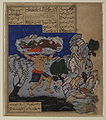ފައިލު:Shahnameh - The Div Akvan throws Rustam into the sea.jpg

Size of this preview: 528 × 600 pixels. Other resolutions: 211 × 240 pixels | 423 × 480 pixels | 676 × 768 pixels | 902 × 1,024 pixels | 1,804 × 2,048 pixels | 2,767 × 3,142 pixels.
Original file (2,767 × 3,142 pixels, file size: 2.99 MB, MIME type: image/jpeg)
ޞަފްޙާގެ ތާރީޚް
Click on a date/time to view the file as it appeared at that time.
| ތާރީޚް/ގަޑި | ތަމްބްނެއިލް | Dimensions | މެމްބަރު | ޚިޔާލު | |
|---|---|---|---|---|---|
| މިހާރު | 19:27, 11 ސެޕްޓެމްބަރު 2009 |  | 2,767 × 3,142 (2.99 MB) | Yann | full size |
| 23:21, 6 ޖޫން 2008 |  | 1,024 × 1,163 (220 KB) | DrFO.Jr.Tn | {{Information |Description={{en|1=This painting represents an episode described in Firdawsi's "Shahnamah" (The Book of Kings), the epic story of ancient kings and heroes of Persia composed by the renowned author during the first decades of the 11th centur |
ފާލަންތައް
The following page uses this file:
Global file usage
The following other wikis use this file:
- Usage on ar.wikipedia.org
- Usage on ba.wikipedia.org
- Usage on bg.wikipedia.org
- Usage on bn.wikipedia.org
- Usage on bs.wikipedia.org
- Usage on ca.wikipedia.org
- Usage on ce.wikipedia.org
- Usage on de.wikipedia.org
- Usage on en.wikipedia.org
- Usage on es.wikipedia.org
- Usage on eu.wikipedia.org
- Usage on fa.wikipedia.org
- Usage on hy.wikipedia.org
- Usage on ja.wikipedia.org
- Usage on ka.wikipedia.org
- Usage on kk.wikipedia.org
- Usage on ku.wikipedia.org
- Usage on ru.wikipedia.org
- Usage on sh.wikipedia.org
- Usage on sq.wikipedia.org
- Usage on ta.wikipedia.org
- Usage on te.wikipedia.org
- Usage on tt.wikipedia.org
- Usage on uk.wikipedia.org
- Usage on ur.wikipedia.org
